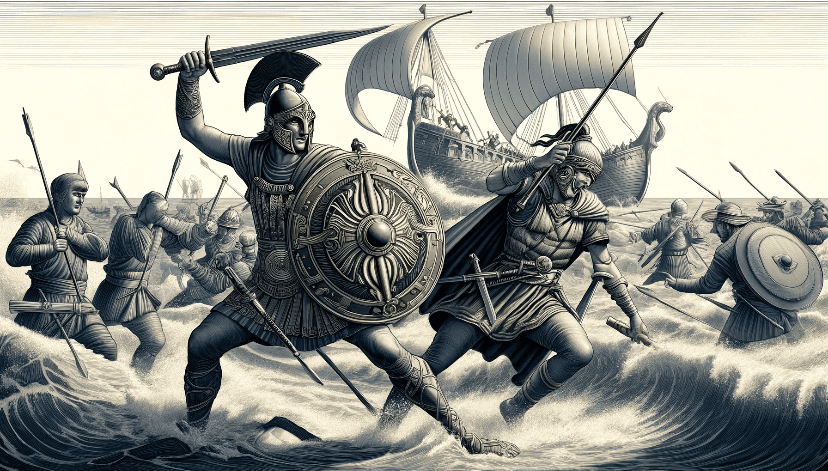"Forgotten Sea Peoples: The Lost Mystery of the Ancient Mediterranean"

Sea Peoples refers to a group of maritime communities that lived in various regions of the Mediterranean in ancient times. These communities, B.C. They appeared on the stage of history in the 12th and 13th centuries. The Sea Peoples consisted of tribes who generally lived nomadic lives and carried out trade and invasions by sea.
The identities and origins of the Sea Peoples are still not fully clarified, but they include Peleset (possibly Philistines), Tursash (possibly Troids), Lukka (possibly Lycians), Danaan (possibly Greeks), Shekelesh (possibly Sicilians), and Shardana (possibly Philistines). There were probably groups such as Sardinians).
The Sea Peoples carried out various invasions against Egypt, the Hittite Empire, and other neighboring civilizations. These invasions were recorded by historians of Egypt and other great kingdoms. Invasions of the Sea Peoples caused large-scale conflicts and migrations in the Eastern Mediterranean region and had a major impact on the history of this period.
The end of the Sea Peoples came when they disappeared from the stage of history and their civilization weakened for various reasons. Traces of these communities were erased over time, and it became difficult to obtain precise information about which ethnic groups they were. However, the Sea Peoples took their place in the pages of history as an important player in the ancient world and entered into conflicts with great empires.
3200-year-old inscription reveals 'mysterious sea people' are from Anatolia
An ancient inscription in the Luwian language found near Afyon in 1878 was deciphered for the first time. The research conducted by a group of Dutch and Swiss archaeologists revealed that the invaders from the sea, who played a role in the end of the Bronze Age and were referred to as 'mysterious sea people' in ancient Egyptian documents, were the indigenous people of Anatolia.
New finds were unearthed in the Ancient City of Pisidia Antiokheia
According to the Independent, experts managed to decipher a 3200-year-old inscription with ancient hieroglyphs found in Turkey.
Researchers say the ancient writing may provide answers to 'one of the greatest discoveries of Mediterranean archaeology'.
According to the news, in 1878, a 29-meter frieze made of limestone was found in Beyköy village, 34 km north of Afyonkarahisar.
French archaeologist George Perrot copied the limestone before villagers took it away to use it as building material for the foundation of a mosque.
'LONGEST HIEROGLYPH FROM THE BRONZE AGE'
The ancient inscription, which is said to be the longest hieroglyph left from the Bronze Age, is in the ancient Luwian language, which can only be read by a few people in the world.
The new findings were revealed by the work of a group of Swiss and Dutch archaeologists.
Dr. is one of the 20 people in the group who can read the Luwian language in the world. Fred Woudhuzien is also present.
Woudhuzien also translated the ancient inscription.
'THE IDENTITIES OF MYSTERIOUS SEA PEOPLE ARE REVEALED'
It is stated that the text may shed light on how the developed and powerful civilizations of the Bronze Age collapsed.
The ancient text describes how the kingdoms in Asia Minor (Anatolia) formed a united navy against the Hittites and conquered the coastal cities in the Eastern Mediterranean.
Researchers state that the text was written in 1190 BC by Kupanta-Kurunta, the king of Mira, one of the late Bronze Age kingdoms.
According to the inscription, Anatolian civilizations, including Mira, occupied ancient Egypt and other regions in the Eastern Mediterranean before and during the end of the Bronze Age.
Archaeologists have long noted that the uncontrolled and sudden collapse of dominant civilizations around 1200 B.C. was partly driven by seaborne raids.
The famous Trojan War, which started as a result of the Mycenaean Civilization's attack on Anatolia, took place at the end of this period, and the collapse of the Mycenaean civilization on the winning side after the war started the 'Dark Age' (the first period of the Middle Ages) that would last for centuries instead of the Bronze Age.
However, the identity of these mysterious merpeople, which today's academics call 'Trojan Merpeople', has been a matter of debate for a long time.
In ancient documents found in Egypt, it was stated that mysterious sea people invaded Cyprus and Syria.
'ONE OF THE BIGGEST PUZZLES IN MEDITERRANEAN ARCHEOLOGY CAN BE SOLVED'
The copy of the text was found among the belongings of British ancient historian James Mellaart after his death in 2012.
Melleart's son gave the copy of the text to Dr. President of the Luwian Research Foundation. He gave it to Eberhard Zangger.
Dr., a Swiss linguist and Luwian language expert. Zangger evaluated the findings with the following words:
"The Luwians from western Anatolia certainly contributed to the so-called 'Sea People Invasions' and thus the end of the Bronze Age in the Eastern Mediterranean. In this way, one of the greatest puzzles in Mediterranean archaeology can be plausibly solved."


